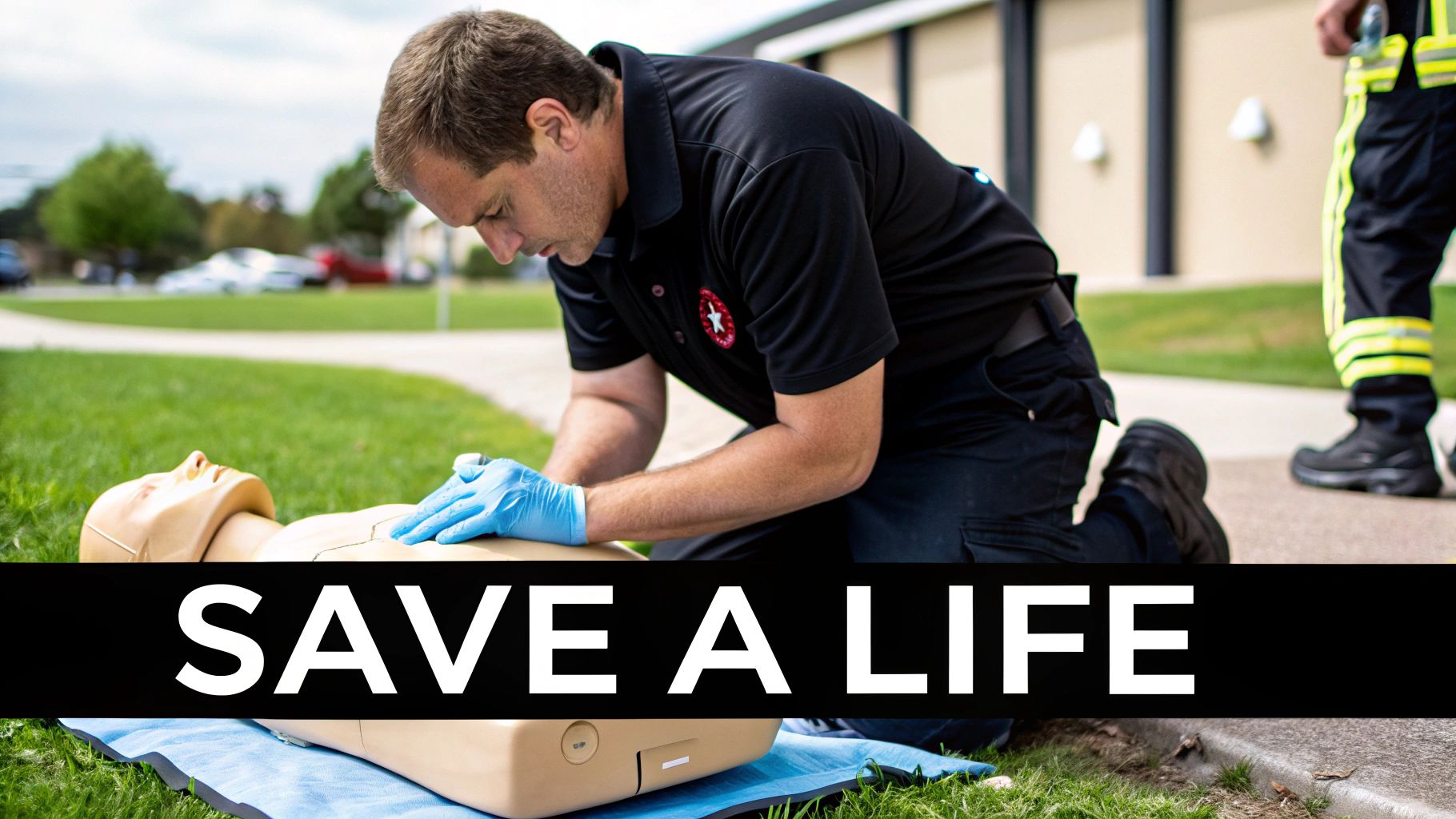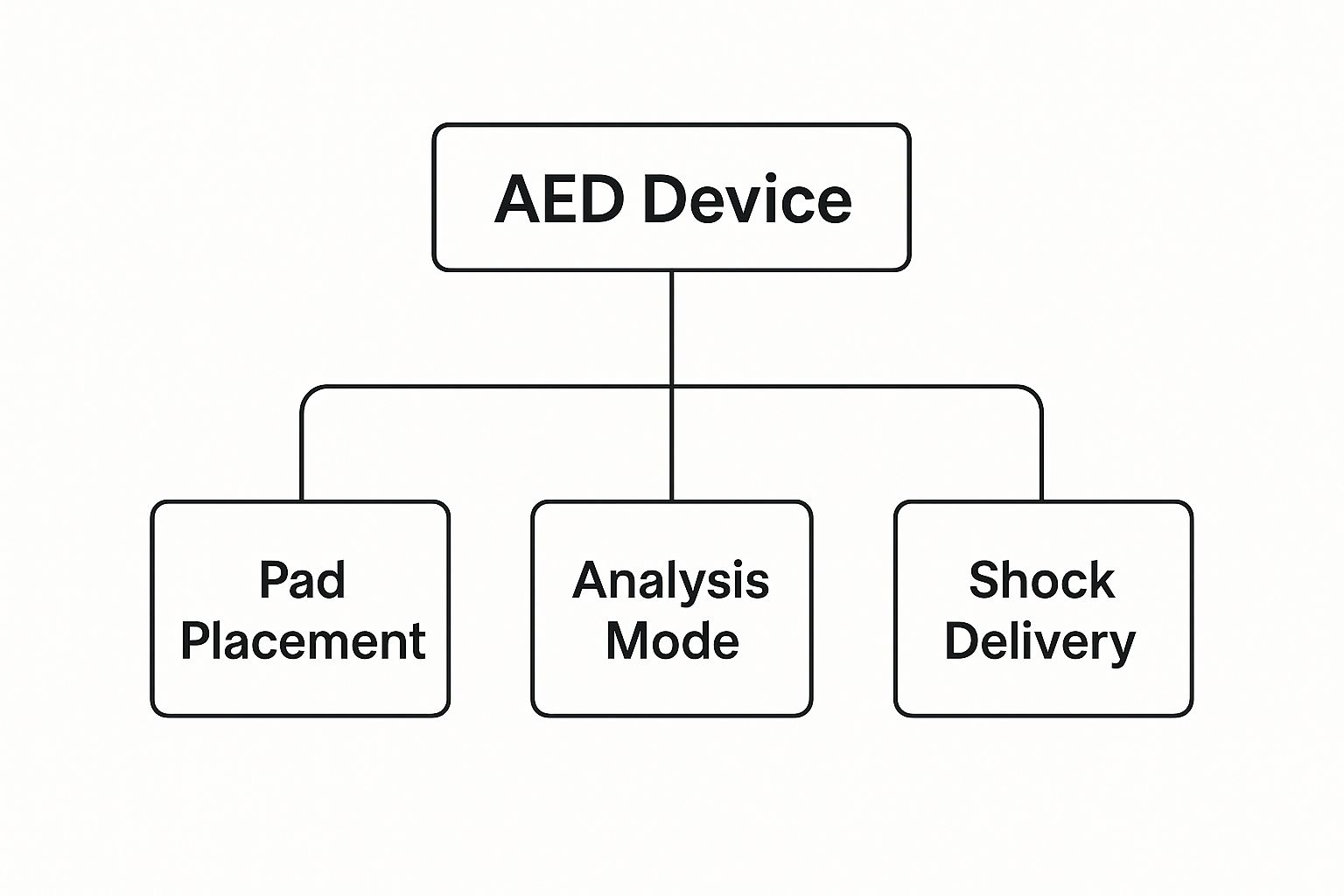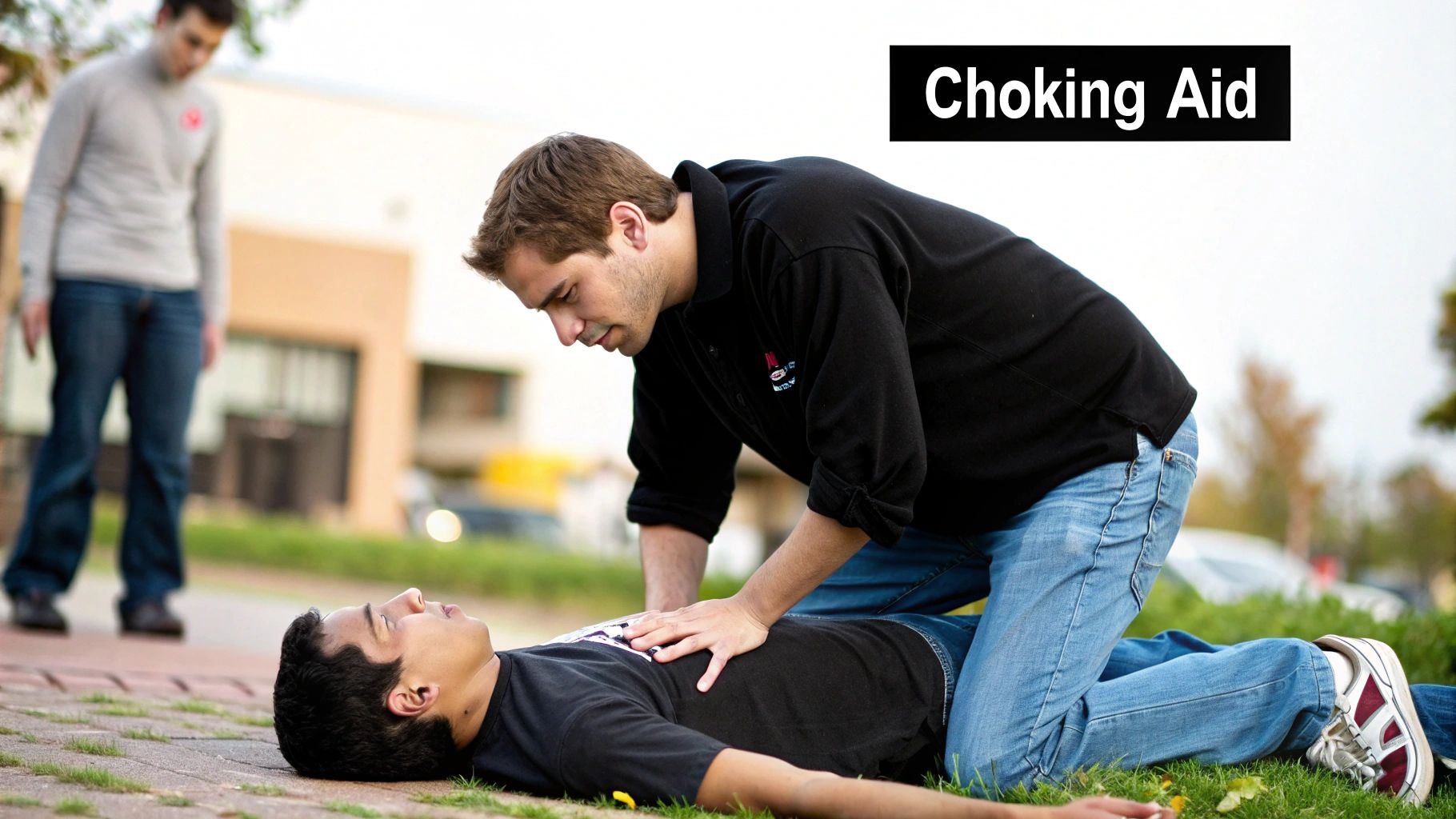Imagine this: you're at a family picnic, a company outing, or just a quiet day at the park. Suddenly, someone collapses. In those critical minutes before paramedics arrive, the most important person isn't a doctor miles away—it's you. This is why First Aid Heartsaver training is so much more than a certificate; it’s the confidence and skill to become a vital link in the chain of survival.
Why This Training Is a Lifeline
Look, First Aid Heartsaver isn't built for doctors or nurses. It's designed for everyone else: parents, teachers, office workers, and anyone who wants to be prepared to act when an emergency strikes. The whole point is to bridge that dangerous gap between when an incident happens and when professional help gets there. When you're prepared, you transform from a helpless bystander into a capable first responder.
This course moves beyond just theory and gets right into the practical, hands-on skills that build real confidence. You'll learn to recognize and manage some of the most common and life-threatening emergencies.
- Handling Medical Crises: You'll gain the ability to spot the signs of a heart attack, stroke, or a severe allergic reaction and know the immediate steps to take.
- Managing Injuries: Learn how to control severe bleeding, stabilize a potential broken bone, and treat burns to prevent an injury from getting worse.
- Responding to Environmental Threats: Understand how to help someone suffering from heat stroke or hypothermia.
The value of this knowledge becomes crystal clear when you look at the stats. In the United States, over 350,000 cardiac arrests happen outside of a hospital every single year. Sadly, only about 40.2% of victims get the bystander CPR they desperately need. Prompt action can double or even triple a person’s chance of survival.
Beyond your own skills, widespread first aid training has a massive impact on community health and public safety. These are areas often supported by broader initiatives. To get a sense of the funding that supports these crucial health programs, it's worth exploring resources on healthcare grants.
Ultimately, this course empowers you to be a calm, reassuring presence in a moment of chaos. It gives you a clear plan of action when panic might otherwise take over. As you keep reading, you'll see the specific skills you'll master and how they apply to everyday life. For more on emergency preparedness, check out our other articles on the Ready Response blog.
Decoding the AHA Heartsaver First Aid Course

So, what exactly is the AHA Heartsaver First Aid course? Think of it as the go-to emergency preparedness class for anyone who isn't a medical professional. It’s built from the ground up for people who need to be ready to act but don’t have years of clinical training behind them.
This course is designed for everyday heroes—parents, teachers, construction workers, and anyone who wants the confidence to handle an emergency. It cuts through the complex medical jargon and gets straight to what matters in those first few critical minutes: taking confident, decisive action.
The curriculum is all about building practical skills, not just memorizing facts. You'll get your hands dirty with practice that feels like the real deal, ensuring that if a crisis ever happens, your training kicks in like muscle memory.
Who the Course Is Built For
Let's be clear: the American Heart Association’s Heartsaver First Aid course is essential for equipping non-medical individuals with lifesaving skills. It’s specifically tailored for people with little or no medical background who need a certification for their job, a regulatory body, or just for their own peace of mind.
The training teaches you how to recognize common emergencies, know when to call for help, and manage the scene safely until the pros arrive. The whole philosophy is about empowerment. It’s not about turning you into a paramedic overnight. It’s about giving you a clear, repeatable plan for the most common emergencies.
The Heartsaver First Aid course is about turning bystanders into lifesavers. It provides the essential framework for recognizing a problem, making the scene safe, and providing critical care until EMS can take over.
You’ll learn how to approach an emergency scene safely, figure out what’s wrong, and provide immediate care. This foundation is crucial because the right actions in those first moments can truly change an outcome.
What to Expect From the Training
The course is structured for real-world application, breaking down emergency response into simple, manageable steps that are easy to recall under pressure. Here’s a look at what you’ll cover:
- First Aid Basics: This covers your duties as a rescuer, keeping both yourself and the victim safe, and how to properly assess what’s going on.
- Medical Emergencies: You’ll learn how to respond to choking, breathing problems, shock, and severe allergic reactions (like using an EpiPen).
- Injury Emergencies: This module is all about the hands-on stuff—controlling bleeding, handling sprains or broken bones, and treating burns.
- Environmental Emergencies: Learn to recognize and treat problems like insect bites, animal stings, and temperature-related issues like heat stroke or hypothermia.
Ultimately, the first aid heartsaver program gives you a reliable playbook for chaos. It’s the confidence of knowing you have a plan when someone you care about needs you most.
What You'll Master in the Heartsaver First Aid Course
Think of the Heartsaver First Aid course not as a list of facts to memorize, but as a practical toolkit for your brain. You’re not just learning steps; you’re building the confidence and core skills needed to handle a wide range of real-world emergencies. The entire curriculum is designed to make you a capable first responder, one skill at a time.
The course is structured around three key areas of emergency care. Each module tackles a different kind of crisis, so you'll feel prepared for whatever life throws your way.
Responding to Medical Emergencies
This is the bedrock of the training. Here, you'll learn to spot the often subtle signs of major medical events and know exactly what to do in those first critical moments. This includes recognizing the symptoms of a heart attack, stroke, choking, or a severe allergic reaction.
For example, we don't just talk about anaphylactic shock; you'll get hands-on practice using an epinephrine auto-injector (like an EpiPen). This kind of muscle memory is what allows you to act quickly and correctly when the pressure is on.
Managing Injury Emergencies
Let's face it, accidents happen. From a simple slip and fall to a more serious incident, this part of the course is all about managing physical injuries. You'll learn how to take control of a scene and provide care that can stop a bad situation from getting worse.
A few of the key skills we'll cover are laid out in the table below.
Heartsaver First Aid Course Modules at a Glance
This table outlines the core skill areas covered in the Heartsaver First Aid course, showing the progression from foundational knowledge to specific emergency responses.
As you can see, the course builds from the ground up, giving you a solid foundation before moving into specific, hands-on techniques.
Handling Environmental Emergencies
Sometimes, the environment itself is the emergency. This module gets you ready to respond to situations caused by extreme heat, cold, or other environmental factors.
You’ll learn to identify and treat conditions like heat stroke, hypothermia, frostbite, and even insect or animal bites. Knowing the right response is crucial—the wrong move in these situations can sometimes make things worse.

The image above breaks down the basic steps for using an AED, one of the most important devices you'll learn about. It shows that even a complex, life-saving tool follows a clear, manageable process.
For those who feel a calling to pass these skills on, taking a first aid instructor course is the perfect next step on your journey.
Who Needs Heartsaver First Aid Certification?

It’s a common myth that first aid training is just for doctors and nurses. The truth is, the American Heart Association’s Heartsaver First Aid course was built for everyone. Emergencies don’t check for credentials before they strike—they happen at the grocery store, at your kid's soccer game, or right in the middle of a team meeting.
The people who truly need these skills are the ones already there. This certification is more than just a piece of paper; it’s about being ready to step up for your family, coworkers, and community when it matters most. Let's talk about who really benefits from this training.
The Proactive Parent
Picture the parent whose number one job is keeping their kids safe. For them, a scraped knee is one thing, but they want to be prepared for the bigger stuff. For this parent, Heartsaver First Aid certification isn't just a skill—it's peace of mind.
They know that kids are curious and accidents happen. Being able to confidently handle choking, a sudden allergic reaction, or a bad fall means they can take control and provide real help while waiting for 911. It transforms that feeling of parental anxiety into calm, prepared confidence.
The Dedicated Teacher
Now think about a teacher in a bustling classroom. They’re not just responsible for education; they're responsible for the safety of every single student in their care. For teachers, this certification is a fundamental part of that commitment.
From a fall on the playground to an unexpected medical issue, a trained teacher can manage the scene, give immediate care, and keep other students calm. It’s a skill that makes them an invaluable asset to their students and the entire school. To see how these skills connect with others, check out our guide on getting your CPR and AED certification.
The Office Safety Lead
Finally, imagine the person in your office who's in charge of workplace safety. Whether your office has a dozen people or a few hundred, medical emergencies can happen to anyone, anytime.
Having team members with Heartsaver First Aid training is a critical piece of a solid workplace safety plan. It means that if a colleague suddenly becomes ill or gets injured, there’s someone right there who knows exactly what to do.
OSHA consistently recommends that workplaces have trained personnel on-site to provide immediate assistance. A quick, knowledgeable response in the first few minutes can dramatically improve a person's outcome before professional help arrives.
Beyond these examples, a whole host of professions either recommend or flat-out require this certification, especially those involving public interaction or direct care. This includes:
- Childcare Providers: Essential for managing the daily health and safety of young children.
- Personal Trainers: To respond correctly if a client is injured or has a medical event during a workout.
- Security Personnel: Often the first on the scene in any emergency within a public or private facility.
- Construction Workers: For handling injuries in a high-risk environment where seconds count.
- Coaches and Camp Counselors: To keep athletes and campers safe during activities.
How to Get Certified and What to Expect

So, you're ready to jump in and earn your first aid heartsaver certification. That’s a fantastic decision. The whole process is probably more straightforward than you imagine, and our goal is to make sure you feel confident from the moment you sign up to the day you get your card.
First things first, you have a couple of ways to get trained, designed to fit different schedules and learning styles. The most traditional route is the fully in-person class, which gives you a hands-on learning experience with an instructor from start to finish.
The other popular path is the blended learning model. This is a great mix of flexibility and practical instruction. You'll complete the book-smart portions online at your own pace, then come in for a focused, in-person session to practice your skills with an instructor.
Your Training Day Experience
During the class, expect to be active and involved. An AHA-certified instructor will walk you through a variety of emergency scenarios, making sure you understand not just what to do, but why you're doing it. You'll get plenty of practice with training manikins and other essential gear.
The final step is a skills test. This isn't a scary exam; it’s simply a chance for you to show the instructor that you can confidently perform the first aid techniques you’ve learned. It's all about making sure you're truly prepared to step up in a real emergency.
Once you successfully complete the course and skills test, you'll receive your official American Heart Association Heartsaver First Aid eCard. This digital card is your proof of training and is recognized nationwide.
Globally, first aid and Heartsaver certifications are recognized based on various regional and international guidelines. Here in the United States, the American Heart Association’s Heartsaver First Aid and AED training is a foundational qualification, showing a wide consensus on the need for standardized first aid education.
Keeping Your Skills Sharp
Your first aid heartsaver certification is valid for two years. This two-year cycle isn't arbitrary; it ensures that everyone stays up-to-date with the latest emergency response protocols and gets a chance to refresh their hands-on skills. Think of it as a quick tune-up for your life-saving knowledge.
When your certification is about to expire, the renewal process is simple. You’ll just need to take a shorter renewal course that reinforces your core skills and gets you caught up on any new guidelines. To learn more, check out our guide on CPR and First Aid renewal. At Ready Response, we make it easy to book your renewal so you can stay prepared without any interruption.
Your Path to Certification with Ready Response
So, you're ready to get your AHA Heartsaver First Aid certification. That's fantastic. This is more than just checking a box for a job requirement—it’s about stepping up and being prepared to act when someone desperately needs help. At Ready Response, we take that responsibility seriously, and our goal is to make sure you walk away with real, life-saving skills.
Our instructors aren’t just reading from a manual. They’re experienced professionals who create a hands-on, supportive class where you’ll do more than just listen. We believe confidence is built through practice, so we fill our courses with realistic scenarios. This way, you're not just learning the steps; you're building the muscle memory to perform them correctly under pressure.
Training That Fits Your Life
We get it—life is busy. That's why we don't believe in a one-size-fits-all schedule. Whether you're an individual looking to get certified on your own time or a manager needing to train an entire crew, we have an option that works.
- Individual Courses: Perfect for anyone who wants to be prepared, from parents to community volunteers.
- On-Site Group Training: We’ll bring the entire training setup directly to your workplace. It's the most convenient way to get your whole team certified without the travel hassle.
Becoming certified is the first step toward strengthening the chain of survival in your community. Every trained individual represents another chance for a positive outcome during a crisis.
Don't wait for an emergency to wish you'd been prepared. Join the community of lifesavers we're building at Ready Response and gain the confidence to make a difference.
Common Questions About Heartsaver Training
Even after going through all the details, it's totally normal to have a few more questions pop up before you decide to sign up. We've put together some of the most common ones we hear about First Aid Heartsaver training to give you clear, straightforward answers. Our goal is for you to feel completely confident when you enroll.
Is This the Same as a CPR Course?
No, they are different courses, but they work together perfectly. Think of them as two essential chapters in the same life-saving manual. The Heartsaver First Aid course is all about responding to injuries, medical problems like strokes, and environmental emergencies.
A CPR/AED course, on the other hand, is a separate certification that focuses specifically on how to respond when someone goes into sudden cardiac arrest. While some training bundles include both, they are distinct skills. Many people wisely choose to take both courses to feel fully prepared for whatever an emergency throws their way.
How Long Does My Certification Last?
Your official American Heart Association (AHA) Heartsaver First Aid certification is good for two years. This two-year cycle ensures your skills stay fresh and up-to-date with the very latest life-saving guidelines.
Before your card expires, you'll just need to take a renewal course. These are usually shorter, designed to refresh your knowledge and give you a chance to practice your hands-on skills again, keeping your certification active without any gaps.
Recertification isn't just about checking a box; it's a commitment to being ready. Consistent practice is what truly makes the difference when you're faced with a real emergency.
Are There Any Prerequisites?
Nope, none at all. The great thing about the Heartsaver course is that it’s designed for absolutely everyone. You don't need any prior medical training or experience to jump in.
This course was built for the general public—parents, teachers, coaches, office workers, and anyone who simply wants to know what to do in an emergency. If you have the desire to learn how to help someone, you are the perfect person for this class. For more answers, you can always check out our comprehensive FAQs page.
